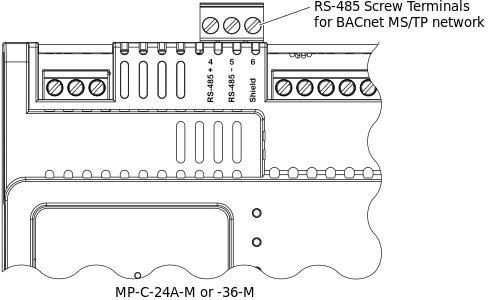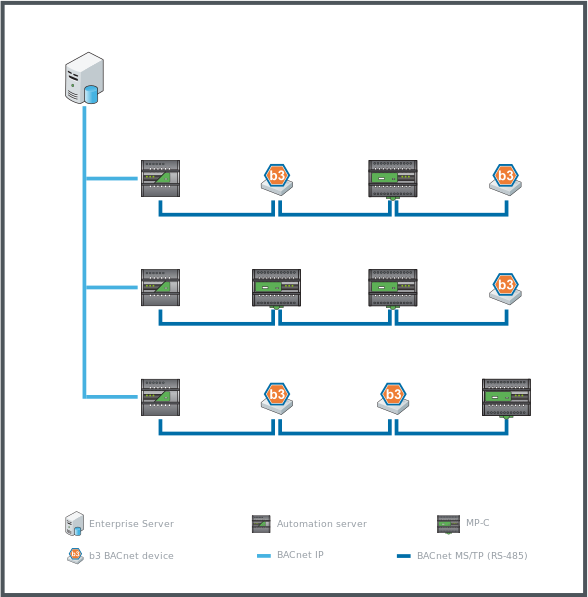
Concept
MP-C BACnet MS/TP Support
The support for BACnet MS/TP communication differs between the MP-C controller models. Only MP-C models with “-M” in the product name support BACnet MS/TP. These MP-C models are designed for connection to a BACnet MS/TP (RS-485) network and can only communicate with automation servers using the BACnet MS/TP protocol.
This category of MP-C controllers (with “-M” in the product name) consists of the following models:
MP-C-24A-M and MP-C-36A-M
The MP-C models without “-M” in the product name are designed for connection to an IP network and can only communicate with automation servers using the BACnet/IP protocol.
For more information, see MP-C Models .
The MP-C controllers with “-M” in the product name have an RS-485 port with a 3-pole removable screw terminal block that is used for connection to the BACnet MS/TP (RS-485) network and MS/TP communication with the automation server (AS-P or AS-B). Connecting to an IP network is not supported as these MP-C controllers do not have Ethernet ports. For more information, see Communication Ports on MP-C-24A-M and -36A-M .
You need to configure a unique MS/TP address for the device during installation using the address DIP switches on the device. For more information, see MS/TP DIP Switches .
As part of the commissioning process for the device, you also need to configure the baud rate for the automation server BACnet MS/TP (RS-485) bus. For more information, see MS/TP Communications Baud Rate .

The MP-C controllers can be mixed with b3 BACnet devices on the BACnet MS/TP (RS-485) network. For more information, see RS-485 Communications .
The MP-C controller models with “-M” in the product name are not isolated and connection of the controllers to a network comprised of isolated RS-485 interfaces is not recommended. The RS-485 application guidelines provide additional details. For more information, see RS-485 Communications .
A mix of up to 50 devices per RS-485 Com port can be connected to an automation server.

 Hardware Overview
Hardware Overview
 MP-C Controllers
MP-C Controllers
 MP-C Models
MP-C Models
 RS-485 Communications
RS-485 Communications
 Wiring
Wiring
 Communication Ports on MP-C-24A-M and -36A-M
Communication Ports on MP-C-24A-M and -36A-M
 MS/TP Communications Baud Rate
MS/TP Communications Baud Rate
 BACnet MS/TP Network Communications
BACnet MS/TP Network Communications
 Configuring MS/TP Network Settings
Configuring MS/TP Network Settings
 MS/TP DIP Switches
MS/TP DIP Switches
 Configuring the MS/TP Address
Configuring the MS/TP Address